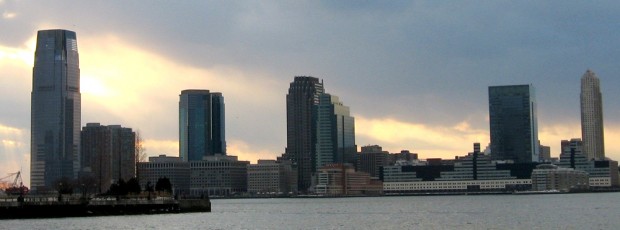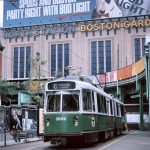New Jersey Future Blog
Is Jersey City a Suburb? Joel Kotkin Thinks So.
March 3rd, 2011 by Tim Evans
Earlier this week, a friend who works for the city of Jersey City emailed Joel Kotkin’s column, in which Kotkin attempts to downplay the idea of an urban renaissance:
Point One: America is becoming more suburban.
For much of the past decade, there has been a constant media drumbeat about the “return to the cities.” Urban real estate interests, environmentalists and planners have widely promoted this idea…
…
The Census reveals that, contrary to the “back to the city” rhetoric, suburban growth continues to dominate in most regions of the country, constituting between 80% and 100% of all growth in all but three of the 16 metropolitan areas reporting.
New Jersey Future has certainly been part of this “drumbeat” (see here, here, here, and here) heralding the urban comeback. So have many national sources, including USA Today and the Environmental Protection Agency (pdf), as well as respected experts on metropolitan growth, ranging from Richard Florida to Christopher Leinberger to New Jersey’s own James Hughes and Joseph Seneca (pdf).
Our Jersey City friend flagged this Kotkin article because it doesn’t square with what he’s seeing on the ground there, or with all of the linked articles above about the return to the cities. Are we all wrong? Is the resurgent city just wishful thinking?
Or is there something misleading about Kotkin’s analysis? Those familiar with Kotkin know that he is a frequent critic of cities and defender of suburbia, so it is not unreasonable to harbor the suspicion that he might be slanting his analysis to lowball the degree to which many of the country’s (and New Jersey’s) urban areas are reviving their fortunes.
In fact, this is exactly what he’s doing. It’s easy to say that “America is becoming more suburban” when you define “suburb” so loosely that it includes just about everything. The problem with Kotkin’s analysis is in his very expansive definition of “suburb.”
Defining “suburb” is a tricky proposition to begin with, since the term is largely subjective—so subjective, in fact, that the Office of Management and Budget (which sets the standards for delineating metropolitan areas) explicitly refrains from doing so in its “Statistical Area Definitions and Guidance on Their Uses” [pdf — see bottom of p.1]:
OMB establishes and maintains the definitions of Metropolitan and Micropolitan Statistical Areas… solely for statistical purposes…The Metropolitan and Micropolitan Statistical Area Standards do not equate to an urban-rural classification; many counties included in Metropolitan and Micropolitan Statistical Areas, and many other counties, contain both urban and rural territory and populations.
[emphasis added]
The Census Bureau likewise declines to include a “suburban” category in its methodology for classifying territory as either “urban” or “rural.”
In the absence of any official definition of what constitutes a suburb, many analysts (Kotkin is certainly not alone here) plow ahead anyway and use Census/OMB geographies to piece one together. They partition the population as follows:
- “urban” = population in the “principal city” (or cities) of a metropolitan statistical area (MSA)
- “suburb” = population in an MSA but not in a principal city
- “rural” = population not in an MSA
This may sound reasonable at first glance. But consider that every county in New Jersey is part of one MSA or another. New Jersey would thus contain no rural territory by this definition; everything is at least “suburban,” including all of Salem County (the home of Cowtown).
This unauthorized typology begins to look even more faulty when you read the definition of a “principal city” and see how limited it is:
The Principal City (or Cities) of a CBSA [Core-Based Statistical Area, the general term for Metropolitan and Micropolitan areas] will include:
(a) The largest incorporated place with a 2010 Census population of at least 10,000 in the CBSA or, if no incorporated place of at least 10,000 population is present in the CBSA, the largest incorporated place or census designated place in the CBSA; and
(b) Any additional incorporated place or census designated place with a 2010 Census population of at least 250,000 or in which 100,000 or more persons work; and
(c) Any additional incorporated place or census designated place with a 2010 Census population of at least 50,000, but less than 250,000, and in which the number of workers working in the place meets or exceeds the number of workers living in the place; and
(d) Any additional incorporated place or census designated place with a 2010 Census population of at least 10,000, but less than 50,000, and at least one-third the population size of the largest place, and in which the number of workers working in the place meets or exceeds the number of workers living in the place.
Applying this definition to the entire New York MSA yields a grand total of seven principal cities [pdf — see p. 49 (labeled as p. 43)]:
35620 New York-Northern New Jersey-Long Island, NY-NJ-PA Metropolitan Statistical Area
Principal Cities: New York, NY; Newark, NJ; Edison, NJ; White Plains, NY; Wayne, NJ; Union, NJ; New Brunswick, NJ
That’s it. Only five New Jersey municipalities make the list, three of which (Edison, Union and Wayne) are more like the kind of places most people, probably including Kotkin himself, have in mind when they think of the suburbs. (Wayne, incidentally, is the hometown of — and inspiration for — the unabashedly suburban rock band Fountains of Wayne, who frequently sing about life in the North Jersey suburbs.)
More tellingly, consider some North Jersey cities that are NOT on the list: Paterson (New Jersey’s third-largest city), Elizabeth (fourth-largest), Clifton, Passaic, Orange, East Orange, Bayonne, Perth Amboy, Plainfield, Hackensack, Linden and Rahway. Not to mention Union City, West New York and Hoboken, three of the most densely populated municipalities in the entire United States (all three exceed 30,000 people per square mile). Not to mention a whole host of smaller but still “urban” places such as Asbury Park, Keansburg, Neptune, Long Branch, Garfield…
Oh, and Jersey City, the 2nd-largest city in the state.
All of these places fail to meet one or the other of the four criteria for qualifying as a “principal city.” In other words, they are all “suburbs” by Kotkin’s definition. That’s right, Jersey City is a suburb. In fact, so are 23 of the 30 “distressed urban communities” identified by the Housing and Community Development Network in its Cities in Transition report of 2006.
Using Kotkin’s definition, it’s not surprising that most of the country’s (and New Jersey’s) population growth is in suburbs, because most of the population lives in his definition of suburbs. But this oversimplified (and non-Census- or OMB-endorsed) taxonomy fails to capture the full range of places that are participating in the urban revival and hence understates its extent.
Which, one suspects, was the point.
UPDATE [3-25-11]: Yonah Freemark at Transport Politic contributes a more nuanced analysis of some of the supposedly declining cities cited by Kotkin, noting that many of them experienced population gains in their downtown areas even as the overall city population decreased:
Other Census data tell a different, more polished, story about some of these same cities, requiring a very different explanation:
- Baltimore‘s downtown residential population has grown by 11.6% since 2006 and now provides living space for more than 40,000 people.
- Chicago‘s Loop saw a 76% increase in inhabitants since 2000 and the Near South Side more than doubled in population over the same period (even as the number of jobs downtown declined by 60,000).
- Cleveland‘s most central census tracts
each gained 20% or more in population between 2000 and 2010.- St. Louis‘ central neighborhoods gained several thousand people in total.
Thus, even as citywide population declined in these cities, downtown population increased — in some cases quite dramatically.
He also points to Philadelphia and Newark as having posted their first overall population gains since 1950. How does this square with the facts that Kotkin chooses to (selectively) highlight? Freemark sums it up:
This downtown growth falls closely in line with the narrative that Americans are moving back to the city — it’s just that in many cases they’re only moving to a specific part of it: The high-density downtown.
The Census Bureau itself also weighs in with a few observations that reinforce the “return to the cities” theme:
The District of Columbia experienced its first decennial population increase since the 1940s.
and
Nine of the 10 most populous cities in 2010 gained population over the last decade. Chicago, which grew between 1990 and 2000, was the only one of these cities to decline in population.
Related Posts
Tags: Census, Demographics, Metropolitan issues, Redevelopment


















Great counterpoint to Kotkin! Kotkin also recently wrote about how certain cities one typically doesn’t think of as leading urban centers are attracting the most college grads, more than places like NY and SF. But, as with the error in his categorization skills that you dissect so well above, he seems to assume that a college degree is a college degree is a college degree. Not to sound like a snob, but C students from non-accredited colleges flocking to back-office jobs in Secondary City is not equal to A students from highly competitive universities flocking to dynamic, high value-add jobs in Hip Urban City.
Kotkin tends to see his pre-formed conclusions in data, which is why he has zero credibility with academics, with actual industry professionals in real estate/planning, or with anyone other than libertarian/right-wing anti-transit political groups. It’s easy to be an advanced-degreeless pundit with a fake position at a fake university like Kotkin and just write puff pieces for the anti-urbanites. What’s hard is cleaning up the mess in the built environment (sprawl-related public health problems like obesity, diabetes, etc) like frauds like him are directly responsible for promoting.
Well put JS. Thanks for the feedback!
What else is Kotkin going to say?
He’s owned skin, feathers, and beak by his employer, Chapman University, and its benefactor, George Argyros, a billionaire developer of suburban bigbox strip centers and ticky-tacky housing tracts, who thinks any attempt at urban planning is a communist plot. Kotkin is not a “man of ideas,” he’s a paid shill, with a university brand to make him look legit.
BTW, Chapman is known as a school for rich kids who weren’t smart enough to get into USC, and faculty not smart enough to get into academic journals. So they ply the popular press.
That looks like an older picture, there are more highrises now.
Also that is not a complete picture of the Jersey City skyline, you only see Exchange Place or Wall Street West.
You don’t see the Newport waterfront, which has more highrises.
If you do a google search on images, you will see newer photos.
So let me get this straight. You browbeat Kotkin for having a broad definition of “suburb”. Then you
a.) Didn’t offer one
b.) The definition of principal city still doesn’t say that Jersey City is NOT a suburb. In fact, anyone can rationally deduce that if a city is not one of the principal cities, then it must be a suburb, or rural area.
c.) Prattle on that many suburbs do exhibit characteristics of urban areas and therefore, should not be considered suburbs. Suburbs can be/are dense. They can be diverse.
d.) Falsely equating that lack of skylines is a defining characteristics of suburbs. There are tall buildings in Irvine/Costa Mesa, Century City, and Warner Center, but they are suburbs to Los Angeles.
Jersey City’s population is 250,000. Or half as much as the Phoenix suburb of Mesa, or the Dallas suburb of Arlington. Still smaller than the largest cities of LA’s largest suburb, Orange County.
a) CORRECT. I am unequivocally criticizing Kotkin’s implied definition of “suburb” while refraining from providing one of my own. As I said, defining “suburb” is a highly subjective exercise…I prefer to follow the lead of the very smart people at the Census Bureau and the statistical unit at OMB in declining to undertake what I think is ultimately a fool’s errand. There are a few, narrowly defined instances in which I have proposed a working definition of “suburb” — based on population density — but in those unusual cases I am always careful to lay out exactly what definition I am using (something Kotkin has very pointedly NOT done) so that individual readers can decide for themselves whether or not they agree with my characterization. But generally I avoid making arguments that require me to classify every place in NJ as either urban, suburban, or rural.
b) I’m not sure if I’m completely following your point here, but it appears you are defending the definition of “suburb” that includes Jersey City. Again, because it’s so subjective, I can’t objectively tell you that you’re wrong, exactly. What I CAN tell you is that my regular reading audience would not find me credible if I used a definition of “suburb” that included Jersey City.
c) Your use of the word “prattle” suggests that you’re not really interested in having a civil and productive discussion, but I will attempt to respond to your point anyway. If a “suburb” exhibits characteristics of an urban area, why not call it an urban area? And what, precisely, are those characteristics? Maybe we should define the characteristics in advance, and then see which places fall into which categories. I bet you if you tried to develop such a list of “urban” characteristics in advance, there’s no way you could come up with one that included cities like Cleveland, Baltimore, Pittsburgh, Richmond, Miami, etc. but not Jersey City. Hudson County, where Jersey City is located, is more densely populated than any city in the country besides New York City and San Francisco. Any definition of “urban” that manages to exclude Jersey City is inevitably going to leave out plenty of well-known cities around the country.
d) I’ve said nothing about whether a skyline is either a necessary or a sufficient condition for qualifying as “urban”. I don’t think it’s either, now that you’ve brought it up.
And in your coda, you have chosen some particularly unfortunate examples if your goal was to illustrate that “suburbs” can have large populations and/or tall buildings. If you go to the same source I link to in my post that lists the “principal cities” of each metro area — http://www.whitehouse.gov/sites/default/files/omb/assets/bulletins/b10-02.pdf — and scroll to the Phoenix, Dallas, and L.A. metro areas, you’ll see that Mesa AZ, Arlington TX, and Irvine CA are all principal cities of their respective metro areas. In other words, using Kotkin’s definition (of which you appear to approve), none of those places are suburbs.
Like I said, defining “suburb” is a highly subjective exercise.
BOOM. This post rocks. Never been to this blog before, but you’re a champion.
Someone from Newgeography responded to a link to this I posted on facebook:
It’s a difference between the literal and socio-cultural definition of “suburb.” Urban/rural and metropolitan are two completely different and exclusive constructs. Urban/rural is defined by density at the block group level, so it’s conce…ivable that a tiny portion of, for instance, the Los Angeles metropolitan area is technically “rural.” Metropolitan areas are county-based, and defined primarily by inter-county commuting patterns. Since a place like Jersey City is a sub region of a larger metropolitan area with significant commuter exchange between it, the core, and other nodes in the region, it is certainly a “suburb” within the larger urban region. This doesn’t mean it’s not dense, walkable, or attractive.
However, since their socio-cultural definition of “suburb” is an area full of tract housing, strip malls, and franchise restaurants, the folks at NJFuture take offense to being referred to as such. Perhaps they’d rather be called a “sub-city?”
None of this changes the fact that initial Census 2010 data is showing strong decentralization as metropolitan regions become more multi-polar and new job centers emerge. It’s a major shift from the hub and spoke settlement model of the industrial revolution.
These trends could be viewed as positive for a place like Jersey City. It’s emerging finance job center could mean less reason for NJ residents to work closer to home and to avoid an arduous NYC commute. Instead, the response is an overreaction to being referred to as a “suburb.” Note: the link you posted refers to pieces that did not include any data about New Jersey.
Patrick —
Thanks for passing this along (and for your earlier compliment). Maybe you could direct your Facebook friend here to this original post, where I’ve repeatedly discouraged the idea of attempting to define “suburb”. As the research director here, I can assure you that New Jersey Future does not have a definition — “socio-cultural” or otherwise — of “suburb”, nor do I think it’s worthwhile to pursue one. (I don’t even like to use the word “sprawl”, because it’s similarly indistinct and ultimately meaningless, except in certain very narrowly-defined contexts.)
What I have taken offense to (and I don’t consider it an overreaction, considering that I haven’t seen anyone else make the point) is Joel Kotkin’s abuse of Census/OMB geographic terms in order to create a dishonest counterargument to a very real demographic trend that he finds threatening to his ideology. By calling a lot of things “suburbs” that are more properly described as “urban” (based on variables like population and employment density and lack of remaining buildable land), he is endeavoring to make the “return to the cities” phenomenon look a lot less widespread than it actually is, by severely limiting what counts as “urban”.
Your friend does have a point about the economic dependency angle — that’s one instance where it would be proper to describe Jersey City as a suburb of New York. (Of all employed Jersey City residents who work outside Jersey City, Manhattan is the #1 destination by a very wide margin.) But New Jersey Future is a land use policy organization, so we speak about places in terms of what their built environment looks like, not in terms of where their residents work — commute patterns tell you nothing about what a place looks and feels like, nor about how it functions internally, nor about the likely environmental impacts of building more places that look like it. And as far as its built form, Jersey City (and Paterson, and Elizabeth, and all the other places I enumerated in the original post) is decidedly urban.
Incidentally, I worked at the Census Bureau before going back to school to study planning. I’m thus a big believer both in quantification and in transparency when it comes to defining the terminology you’re using. The Census Bureau excels at both, and I have tried to carry their ethos into my second career.
Again, thanks for keeping the discussion going.
Oh, it wasn’t my friend. It was someone posting on Kotkin’s New Geography facebook page. Could have been Kotkin himself – he’s responded to comments I’ve made on his blog posts before.
See http://www.facebook.com/#!/pages/New-Geography
Oh OK, cool…feel free to post as much of my above reply on their page as you like!
Try this one: http://www.facebook.com/pages/New-Geography#!/pages/New-Geography/112317912517
And by the way, Patrick — I just checked out the New Geography Facebook page, and you are doing an admirable job of combating their anti-urbanist narratives. Keep up the good work, and I’m glad I was able to offer you some useful material.
I read this then listened to the NJ Census results segment on WNYC Brian Lehrer and am confused about the definition of city v suburb and which grew more city or suburb. Here’s a link to the show: http://www.wnyc.org/shows/bl/2011/mar/10/census-results-numbers/.